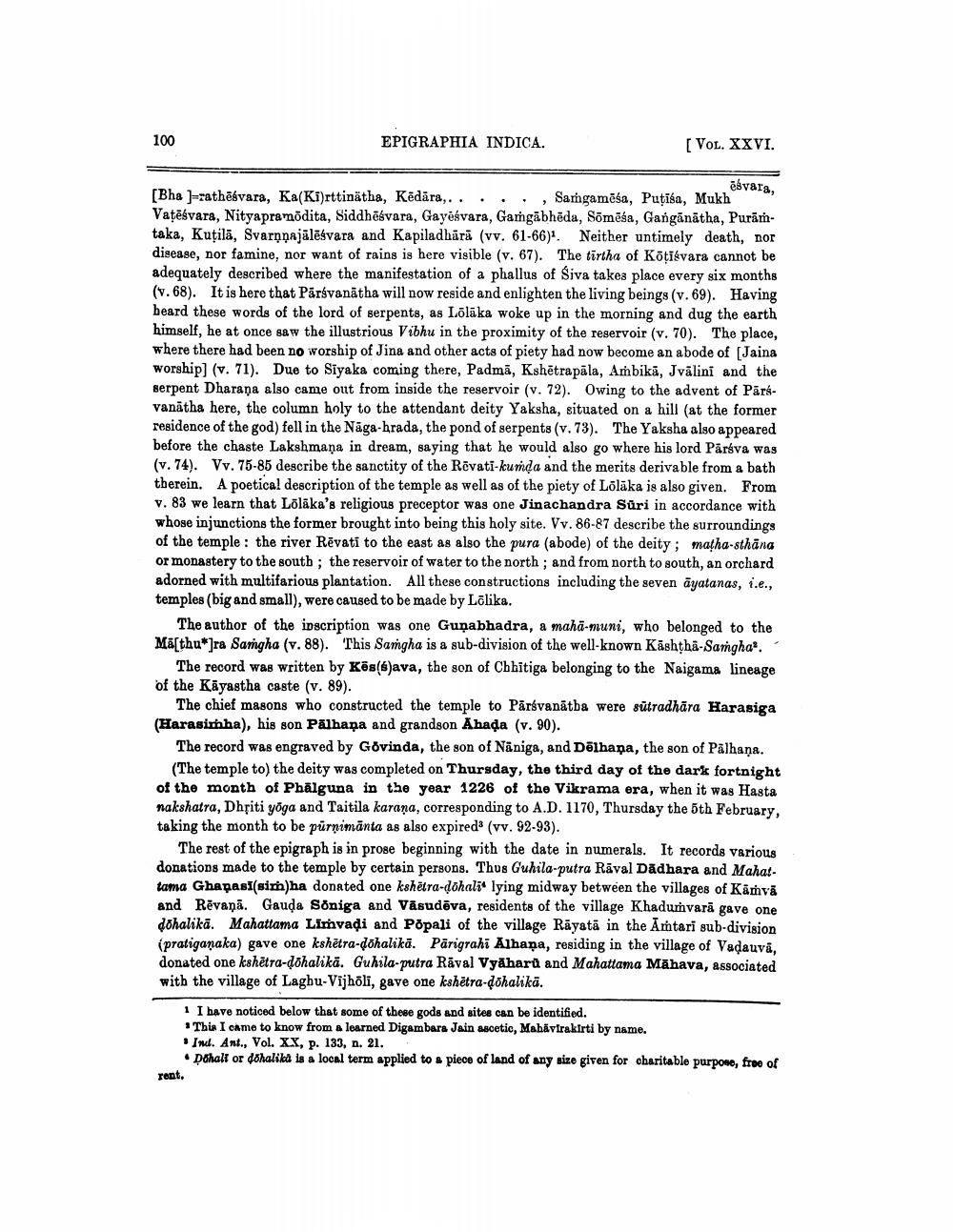________________
100
EPIGRAPHIA INDICA.
(VOL. XXVI.
ē vara, [Bha ]=rathēsvara, Ka(Ki)rttinätha, Kēdāra,.. ..., Sargamēša, Putīša, Mukh Vatēsvara, Nityapramödita, Siddhisvara, Gayėśvara, Gamgäbhoda, Sömēsa, Gangānātha, Purantaka, Kutila, Svarnnajālēgvara and Kapiladhārā (vv. 61-66)". Neither untimely death, nor disease, nor famine, nor want of rains is here visible (v. 67). The tirtha of Köțisvara cannot be adequately described where the manifestation of a phallus of Siva takes place every six months (v.68). It is here that Pärávanātha will now reside and enlighten the living beings (v. 69). Having beard these words of the lord of serpents, as Lolāka woke up in the morning and dug the earth himself, he at once saw the illustrious Vibhu in the proximity of the reservoir (v. 70). The place, where there had been no worship of Jina and other acts of piety had now become an abode of (Jaina worship) (v. 71). Due to Siyaka coming there, Padmā, Kshētrapala, Ambikā, Jvālini and the serpent Dharana also came out from inside the reservoir (v. 72). Owing to the advent of Pārkvanātha here, the column holy to the attendant deity Yaksha, situated on a hill (at the former residence of the god) fell in the Näga-hrada, the pond of serpents (v. 73). The Yaksha also appeared before the chaste Lakshmana in dream, saying that he would also go where his lord Päráva was (v. 74). Vy. 75-85 describe the sanctity of the Rēvati-kumda and the merits derivable from a bath therein. A poetical description of the temple as well as of the piety of Lõlāka is also given. From v. 83 we learn that Lõlāka's religious preceptor was one Jinachandra Sûri in accordance with whose injunctions the former brought into being this holy site. Vv. 86-87 describe the surroundings of the temple: the river Rēvati to the east as also the pura (abode) of the deity; matha-sthāna or monastery to the south; the reservoir of water to the north ; and from north to south, an orchard adorned with multifarious plantation. All these constructions including the seven āyatanas, i.e., temples (big and small), were caused to be made by Lolika.
The author of the inscription was one Guņabhadra, a mahā-muni, who belonged to the Mā[thu*]ra Sangha (v. 88). This Samgha is a sub-division of the well-known Kāshtha-Samgha.
The record was written by Kēs(f)ava, the son of Chhitiga belonging to the Naigama lineage of the Kāyastha caste (v. 89).
The chief masons who constructed the temple to Pārsvanátba were sutradhāra Harasiga (Harasimha), his son Pālhana and grandson Ahada (v. 90).
The record was engraved by Govinda, the son of Nāniga, and Dēlhaņa, the son of Palhaņa. (The temple to) the deity was completed on Thursday, the third day of the dark fortnight of the month of Phālguna in the year 1226 of the Vikrama era, when it was Hasta nakshatra, Dhțiti yoga and Taitila karana, corresponding to A.D. 1170, Thursday the 5th February, taking the month to be purnimānta as also expired (vv. 92-93).
The rest of the epigraph is in prose beginning with the date in numerals. It records various donations made to the temple by certain persons. Thus Guhila-putra Rāval Dădhara and Mahattama Ghanasi(sim)ha donated one kshetra-dohalie lying midway between the villages of Kāmvā and Rēvanā. Gauda Soniga and Väsudēva, residents of the village Khadumvarā gave one dohalika. Mahattama Limvadi and Popali of the village Rāyatā in the Amtari sub-division (pratiganaka) gave one kshetra-dohalikā. Pārigrahi Ajhana, residing in the village of Vadauva, donated one kshetra-dohalikā. Guhila-putra Raval Vyāhard and Mahattama Māhava, associated with the village of Laghu-Vijhõli, gave one kshetra-dohalika.
1 I have noticed below that some of these gods and sites can be identified. * This I came to know from learned Digambara Jain ascetic, Mahavirakirti by name.
Inul. Ant., Vol. XX, p. 133, n. 21.
• Dohalt or dohalika is a local term applied to a piece of land of any size given for charitable purpose, free of rent.




